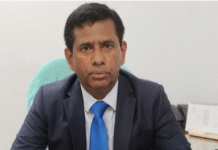
Twitter1200 #Bangladesh: Children make a boat from banana trees to make their way to a flood shelter after heavy monsoon rains. v/@unicef_uk @unicefbdpic.twitter.com/ …
Posted: Sep 01, 2017
By Steve George CNN
(CNN) — In rural villages across northern Bangladesh families are preparing to mark Eid al-Adha, the holiest date in the Muslim calendar.
The date, which translates literally as the “sacrifice feast,” is intended to be a time of great celebration. In small villages, such as Beraberi some 134 kilometers northwest of Dhaka, villagers spent much of the last year hand-rearing goats and cows in anticipation of the annual festivities.
Then the rains began to fall.
As the world’s media trains its sights on the tragic events in Texas and Louisiana, another water-driven catastrophe is unfolding in villages like Beraberi throughout Bangladesh and parts of Nepal and India.
There, the International Federation of Red Cross and Red Crescent Societies (IFRC) estimates that at least 1,200 have died and more than 41 million people have been affected by monsoon rains and severe flooding as of June this year. The rains are now moving northwest towards Pakistan, where more devastation is expected.
At its peak on August 11, almost a week’s worth of monsoon rain was dumped across parts of Bangladesh in the space of one day, according to the country’s Meteorological Department, forcing villagers throughout northern areas to grab what few possessions they could carry and flee their homes in search of higher ground.
And still the rains keep coming. In Bangladesh alone, floods have so far claimed the lives of 142 people, and impacted over 8.5 million.
In Beraberi, one of numerous island villages know as “chars” dotted along the Jamuna River, entire homes have been washed away, and crops and food supplies — including livestock — all but wiped out. When aid workers carrying relief parcels from the IFRC arrived by helicopter earlier this week, villagers described the rains as the “worst in living memory.”
“People were fearful they would soon begin to starve,” says Corinne Ambler, who was among the IFRC team who visited the village. “They are used to seasonal flooding but nothing to this degree, this is a different level — for miles around all you can see is water, the flooding has transformed the countryside.”
Mother of two, Adere Begum, 34, was at home with her daughters when the flooding began. “The water was up to our knees inside. There were snakes in the water and my children were very scared,” said Begum,who lost much of her livestock, including ducks, chickens and cows in the floods.
The IFRC has described the flooding in Bangladesh as the most serious in 40 years. The organization estimates that 700,000 homes have been partially or totally destroyed and up to a third of its terrain — much of it farmland — left submerged, raising fears of a coming food shortage, as the country grapples to deal with a shortfall in staple produce.
“This is the season of rice cultivation,” Reaz Ahmed, Director General, Bangladesh’s Department of Disaster Management told CNN. Almost half of Bangladeshis are employed in the agriculture sector, with rice as the single most important product.
According to government estimates, to date a total of 6,1877 hectares of cropland, mostly rice, have been “completely damaged,” while 531 million hectares have been “partially damaged.”
Recent figures from the the Asian Development Bank, show that 31.5% of Bangladeshis live below the national poverty line. For many of those in the north of the country, where fragile sustenance farming remains the norm, even the slightest drop in crop production can prove devastating.
In areas where the flood waters are receding the government is advising that farmers return in the hope that some crops can yet be salvaged. “Farmers still have around 20 days to re-cultivate rice plants. The Government is providing them seed, saplings and fertilizers,” said Ahmed.
But such efforts are complicated by poor infrastructure. In the north of the country, where the flooding is most acute, a significant number of villages remain entirely cut off, with many major roads and highways inaccessible.
Bangladesh is no stranger to flood related disasters. Much of the country is built on low-lying and flood-prone areas, making it particularly vulnerable to seasonal monsoon rains. In 2007 more than half of Bangladesh was seriously affected by deadly monsoon flooding, leading to over 1,000 deaths, the majority of them children.
A report by the World Bank group lists Bangladesh, a densely populated country of 165 million, as among the world’s “potential impact hotspots” threatened by “extreme river floods” due to global rise in temperatures.
As of August 31, more than than 51,000 people have been relocated to emergency flood shelters set up by the government, according to Ahmed, though that number is expected to rise as food shortages begin to bite and families seek additional assistance.
The sheer number of displaced people would be a monumental challenge for any government, but in Bangladesh, where as many as 27,000 Rohingya refugees have this week arrived across the border from Myanmar — joining an estimated 85,000 currently housed in camps — the situation becomes additionally perilous.
With the country essentially left combating two separate humanitarian crises, aid agencies are appealing for international assistance.
“Providing clean water and sanitation are major our priorities right. The floodwaters will soon become a breeding ground for deadly diseases such as diarrhoea, malaria, dengue and Japanese encephalitis,” said Antony Balmain, IFRC’s Communications Manager. “As we’ve seen in flood hit parts of Sri Lanka, there is a very real possibility this could yet get much worse.”
CNN’s Sugam Pokharel contributed to this report
TM & © 2017 Cable News Network, Inc., a Time Warner Company. All rights reserved.









